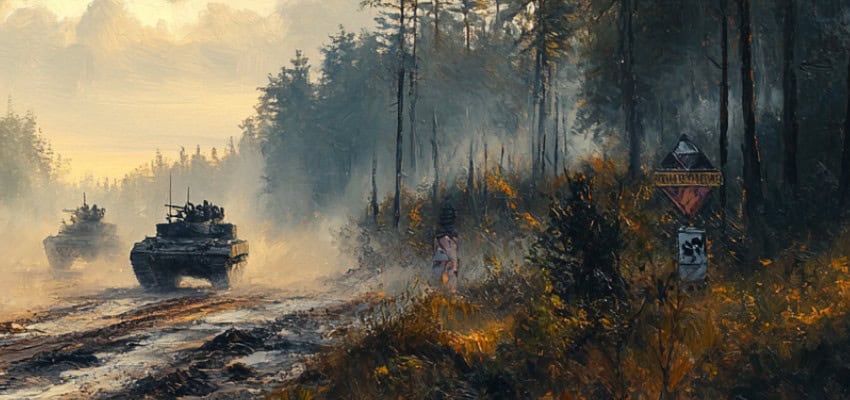Editor’s Note: The following article provides an in-depth analysis of recent developments in the ongoing conflict between Russia and Ukraine, with a particular focus on the significant Ukrainian incursions into Russian territory. These cross-border operations represent a pivotal shift in Ukraine’s military strategy, challenging Russian defenses in Kursk and Belgorod Oblasts. The article explores the implications of these incursions on the broader conflict, including their impact on Russian military operations, international relations, and internal Russian politics. This comprehensive overview is based on verified facts from the latest report by the Institute for the Study of War, dated August 16, 2024.
For those seeking to grasp the full scope of this evolving landscape, the complete updates from the Institute for the Study of War serve as an invaluable resource.
Content Assessment: Ukraine's Bold Move: Incursions into Russian Territory Shift the Conflict
Information - 94%
Insight - 92%
Relevance - 90%
Objectivity - 93%
Authority - 94%
93%
Excellent
A short percentage-based assessment of the qualitative benefit expressed as a percentage of positive reception of the recent article from ComplexDiscovery OÜ titled, "Ukraine's Bold Move: Incursions into Russian Territory Shift the Conflict."
Background Note: ComplexDiscovery’s staff offers distinctive perspectives on the Russo-Ukrainian war and Iran-Israel conflict, informed by military experience on the West German, East German, and Czechoslovakian border during the Cold War and in Sinai as part of Camp David Accord compliance activities. This firsthand regional knowledge has been further enhanced by recent staff travels to Eastern European countries, including Estonia, Latvia, Lithuania, and Poland. These visits have provided up-to-date, on-the-ground insights into the current geopolitical climate in regions directly impacted by the ongoing conflict.
Combined with proficiency in cybersecurity, information governance, and eDiscovery, this multifaceted experience enables comprehensive analysis of these conflicts, including the critical impact of cyber warfare, disinformation, and digital forensics on modern military engagements. This unique background positions ComplexDiscovery to provide valuable insights for conflict-related investigations and litigation, where understanding the interplay of technology, data, and geopolitical factors is crucial.
Russo-Ukrainian Conflict Update*
Ukraine’s Bold Move: Incursions into Russian Territory Shift the Conflict
ComplexDiscovery Staff
The ongoing conflict between Russia and Ukraine, which began with Russia’s full-scale invasion in February 2022, has seen various phases of intense military operations. Recent developments, particularly Ukrainian incursions into Russian territory, signal a significant shift in the nature of the conflict. As of August 16, 2024, Ukrainian forces have undertaken bold cross-border operations, challenging Russian defenses in Kursk and Belgorod Oblasts. These operations not only demonstrate Ukraine’s increasing military capabilities but also have broader implications for regional stability and international relations.
Ukrainian Advances in Kursk and Belgorod Oblasts: The Ukrainian military has carried out a series of operations within Russian territory, notably in the Kursk and Belgorod Oblasts. On August 16, Ukrainian forces continued their incremental advances southeast of Sudzha, Kursk Oblast. This progression, though described as marginal, reflects a sustained effort by Ukraine to disrupt Russian military operations and supply lines. The destruction of two key bridges in the Glushkovo Raion by Ukrainian strikes has further complicated Russian logistical operations in the area, hindering the movement of troops and supplies.
In Belgorod Oblast, Ukrainian forces reportedly advanced further during recent cross-border assaults than previously acknowledged. Although these forces no longer maintain positions in Belgorod as of August 16, the initial incursions were significant. Ukrainian units managed to penetrate up to 10 kilometers into Russian territory near the Kolotilovka border checkpoint. This operation marked one of the deepest incursions into Russian territory since the conflict began.
The Washington Post reported that Ukrainian forces held positions within Belgorod Oblast while under intense Russian airstrikes and artillery fire. The Ukrainian military’s ability to execute such a deep penetration into Russian territory, despite the Russian military’s efforts to repel the assaults, underscores the growing tactical proficiency of the Ukrainian forces.
Russian forces in Belgorod Oblast, according to Ukrainian soldiers, were more prepared to respond to these incursions compared to their counterparts in Kursk Oblast. The presence of extensive “dragon’s teeth” anti-tank fortifications and heavily mined areas suggests that Russia has prioritized the defense of certain border regions more than others. This preparation was evident in the immediate response of Russian artillery units, drone operators, and aircraft, which began striking Ukrainian forces as they attempted to cross the border.
These cross-border operations indicate a shift in Ukrainian strategy, moving from purely defensive operations within its own territory to taking the fight into Russian border regions. This shift has forced Russia to reconsider its military posture along its western borders and has likely strained Russian military resources, which are now tasked with defending a broader front.
Implications of Ukrainian Incursions: The Ukrainian incursions into Russian territory have had several significant implications, both militarily and politically. Most notably, these operations have pressured Russia into reconsidering its approach to prisoner-of-war (POW) exchanges. Ukrainian officials reported that these incursions have forced Russia to initiate discussions on POW exchanges, a development that marks a notable shift in the Kremlin’s stance. Previously, Russian officials had rebuffed Ukrainian attempts to negotiate such exchanges. The Ukrainian incursion, particularly the capture of approximately 2,000 Russian personnel, including conscripts and Chechen “Akhmat” units, has likely played a role in this shift.
Ukrainian Commander-in-Chief Colonel General Oleksandr Syrskyi reported that Ukrainian forces advanced between one and three kilometers in unspecified areas of Kursk Oblast. This advance, coupled with the establishment of a new military commandant’s office headed by Major General Eduard Moskalyov, indicates that Ukraine is not only focused on tactical gains but is also setting up structures to maintain control over captured territories.
International Reactions and Developments: The Ukrainian incursions have drawn attention from international bodies and governments. The Office of the United Nations High Commissioner for Human Rights (UN OHCHR) requested access to the conflict zones in Bryansk, Kursk, and Belgorod Oblasts for human rights monitoring. While Russia’s response to this request remains unclear, the UN’s involvement underscores the growing international concern over the conflict’s expansion into Russian territory.
The United States has reiterated its support for Ukraine’s right to defend itself, with Pentagon Press Secretary Sabrina Singh confirming that the ongoing Ukrainian incursions have not altered the type or volume of weapons provided to Ukraine. This statement indicates that the U.S. remains committed to supporting Ukraine’s military efforts, including cross-border operations, as long as they target military objectives within Russian territory.
Political Shifts within Russia: The Ukrainian operations have also had political ramifications within Russia. The Kremlin has reportedly dismissed Andrei Ilnitsky, an advisor on information policy to former Russian Defense Minister Sergei Shoigu. This move is part of a broader effort to centralize control of Russia’s wartime information policy under the Russian Presidential Administration. The dismissal of Ilnitsky, who had been associated with creating and promoting Russia’s wartime propaganda, including the controversial “Z” symbol, highlights the internal struggles within the Russian government as it seeks to manage the narrative of the conflict.
Russian milbloggers and media commentators have expressed mixed reactions to Ilnitsky’s dismissal. Some view it as a necessary step to streamline Russia’s information policy, while others see it as a dangerous consolidation of media control under the Presidential Administration, potentially making Russian wartime narratives more vulnerable to external influence.
Continued Russian Military Operations: Despite the pressures from Ukrainian incursions, Russian forces have continued their offensive operations in various sectors. In Eastern Ukraine, Russian forces have conducted operations near Chasiv Yar, Toretsk, and Pokrovsk, although these efforts have met with varying degrees of success. Geolocated footage and Russian military claims indicate that Russian forces have made limited advances in these areas, but Ukrainian defenses remain resilient.
In Southern Ukraine, Russian forces have engaged in limited offensive operations in Zaporizhia Oblast and have continued to face challenges in securing their positions against Ukrainian strikes. The Ukrainian Navy’s successful use of naval drones in the Black Sea, resulting in strikes against 18 Black Sea Fleet ships, has further complicated Russian operations in the region.
Incursion Reprise The Ukrainian incursions into Russian territory represent a significant escalation in the conflict, challenging Russia’s ability to defend its borders and maintain control over occupied territories. These operations have not only demonstrated Ukraine’s growing military capabilities but have also had far-reaching implications, forcing Russia to reconsider its approach to POW exchanges and reshuffle its internal political structure.
As the conflict continues, the situation remains fluid, with both Ukrainian and Russian forces adapting to the evolving battlefield dynamics. The international community’s response, particularly from the United States and the United Nations, will be critical in shaping the future course of the conflict. The potential for further escalation remains high, particularly as Ukrainian forces continue to push the boundaries of the conflict into Russian territory.
News Sources
As a leading source for cybersecurity, information governance, and legal discovery insights, including international investigations and litigation, ComplexDiscovery OÜ recognizes the importance of awareness regarding alleged and documented criminal acts, particularly in the context of the Russia-Ukraine conflict. While we, following the lead of the Institute for the Study of War (ISW), do not provide detailed coverage of war crimes in our primary reports, we encourage professionals within the eDiscovery ecosystem to stay informed about these activities. This awareness is crucial for understanding potential future legal actions and responsibilities.
Detailed Reporting with Maps for August 16, 2024, from the ISW – Mouseover to Scroll
2024-08-16-Russian Offensive Campaign AssessmentReview the Detailed Reporting and Maps PDF
About the Institute for the Study of War Research Methodology
ISW’s research methodology relies on both primary and secondary sources, enabling researchers to develop a comprehensive understanding of the situation on the ground. In order to analyze military and political developments in any given area, ISW’s research analysts must wholly understand the systems of enemy and friendly forces. They must also understand the population demographics, physical terrain, politics, and history of that area. This lays the analytical foundation for understanding the reasons for particular developments and fulfilling their assigned research objectives. ISW analysts also spend time in places like Iraq, Afghanistan, and elsewhere in order to gain a better understanding of the security and political situation and to evaluate the implementation of current strategies and policies. Our researchers compile data and analyze trends, producing a granular analysis of developments in areas of research, producing an accurate, high-resolution, timely, and thorough picture of the situation. ISW’s research methodology guarantees its success and commitment to improving the nation’s ability to execute military operations, achieve strategic objectives, and respond to emerging problems that may require the use of American military power.
About the Institute for the Study of War
The Institute for the Study of War advances an informed understanding of military affairs through reliable research, trusted analysis, and innovative education. They are committed to improving the nation’s ability to execute military operations and respond to emerging threats in order to achieve U.S. strategic objectives. ISW is a non-partisan, non-profit, public policy research organization.
Learn more, get involved, and contribute today.
Additional Reading
- From Dissent to OSINT? Understanding, Influencing, and Protecting Roles, Reputation, and Revenue
- [Annual Update] International Cyber Law in Practice: Interactive Toolkit
- Data Embassies: Sovereignty, Security, and Continuity for Nation-States
Assisted by GAI and LLM Technologies
* Sourced and shared with direct express permission from the Institute for the Study of War (ISW).
Source: ComplexDiscovery OÜ


























